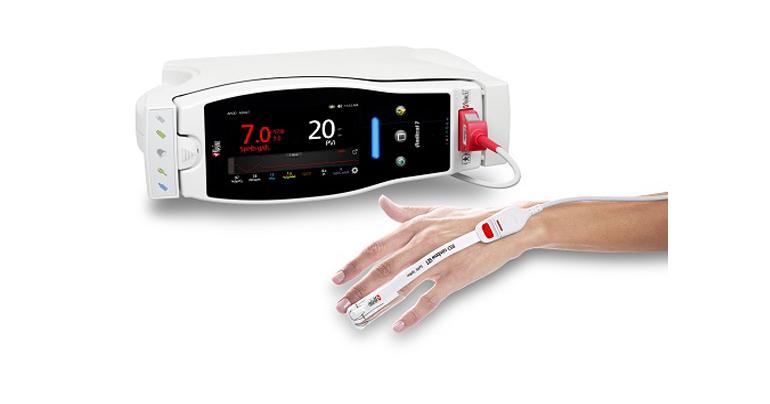New Study Evaluates Ability of Masimo SpHb® (Noninvasive Hemoglobin) to Estimate Timing for Invasive Measurement to Detect Anemia During Surgery
Masimo (NASDAQ: MASI) announced today the results of a study published in BMC Anesthesiology in which clinicians at Peking Union Medical College in Beijing evaluated the ability of noninvasive and continuous hemoglobin monitoring with Masimo SpHb® to help clincians estimate when to conduct invasive hemoglobin measurement to detect possible anemia in patients undergoing spine or cytoreductive surgery.1
Noting that because of the “invasive, time-consuming and intermittent” nature of invasive blood sampling, clincians often forgo these “objective indications” when making transfusion decisions during surgery, Dr. Tang and colleagues sought to determine whether noninvasive, continuous hemoglobin monitoring could aid clinicians in estimating when it might be appropriate to perform an invasive measurement. They enrolled 69 adult patients scheduled for spine surgery or cytoreductive surgery for whom estimated blood loss was more than 15% of total blood volume. The patients were randomly divided into an SpHb group (32 patients) and a standard care group (37 patients). In the SpHb group, diagnostic blood samples were drawn when a patient’s SpHb, measured using a Masimo Radical-7® Pulse CO-Oximeter®, decreased by 1 g/dL. In the standard care group, they were drawn at the clinicians’ discretion. Blood gas analysis was performed using a Radiometer ABL800. The researchers determined the positive predictive value (PPV) of SpHb for the SpHb group and clinician perception in the standard care group in detecting a decrease in lab hemoglobin of more than 1 g/dL or lab hemoglobin of less than 10 g/dL.
The researchers found that the incidence of unnecessary hemoglobin measurement was lower in the SpHb group than the standard care group. For a decrease of greater than 1 g/dL in lab hemoglobin, SpHb had a PPV of 93.3%, compared to 54.5% for clinical perception (p = 0.002). For hemoglobin lower than 10 g/dL, SpHb had a PPV of 86.7%, compared to 50.0% for clinical perception (p = 0.015). In the SpHb group, lab hemoglobin was never less than 7 g/dL. In addition, using Bland-Altman analysis, the researchers calculated that, compared to lab hemoglobin, SpHb had bias and precision of -0.29 +/- 1.03 g/dL, with limits of agreement of -2.30 and 1.72 g/dL. No difference was observed in transfusion units or postoperative hemoglobin concentrations between the two groups.
The researchers concluded, “The SpHb trend tracked changes in hemoglobin satisfactorily during surgery and more accurately estimated the appropriate timing for invasive hemoglobin measurements than the clinicians.” They also noted that “This study was the first diagnostic randomized controlled trial to explore the triage role of Pulse CO-Oximetry in the intraoperative detection of anemia. We found that the trend in SpHb could detect a decrease in Hb in dynamic situations and indicate the appropriate timing for further Hb measurements.”
SpHb monitoring is not intended to replace laboratory blood testing. Clinical decisions regarding red blood cell transfusions should be based on the clinician’s judgment considering, among other factors: patient condition, continuous SpHb monitoring, and laboratory diagnostic tests using blood samples.
About Masimo
Masimo (NASDAQ: MASI) is a global medical technology company that develops and produces a wide array of industry-leading monitoring technologies, including innovative measurements, sensors, patient monitors, and automation and connectivity solutions. Our mission is to improve patient outcomes and reduce the cost of care. Masimo SET® Measure-through Motion and Low Perfusion™ pulse oximetry, introduced in 1995, has been shown in over 100 independent and objective studies to outperform other pulse oximetry technologies.2 Masimo SET® has also been shown to help clinicians reduce severe retinopathy of prematurity in neonates,3 improve CCHD screening in newborns,4 and, when used for continuous monitoring with Masimo Patient SafetyNet™ in post-surgical wards, reduce rapid response team activations, ICU transfers, and costs.5-7 Masimo SET® is estimated to be used on more than 100 million patients in leading hospitals and other healthcare settings around the world,8 and is the primary pulse oximetry at 9 of the top 10 hospitals listed in the 2018-19 U.S. News and World Report Best Hospitals Honor Roll.9 Masimo continues to refine SET® and in 2018, announced that SpO2 accuracy on RD SET™ sensors during conditions of motion has been significantly improved, providing clinicians with even greater confidence that the SpO2 values they rely on accurately reflect a patient’s physiological status. In 2005, Masimo introduced rainbow® Pulse CO-Oximetry technology, allowing noninvasive and continuous monitoring of blood constituents that previously could only be measured invasively, including total hemoglobin (SpHb®), oxygen content (SpOC™), carboxyhemoglobin (SpCO®), methemoglobin (SpMet®), Pleth Variability Index (PVi®), RPVi™ (rainbow® PVi), and Oxygen Reserve Index (ORi™). In 2013, Masimo introduced the Root® Patient Monitoring and Connectivity Platform, built from the ground up to be as flexible and expandable as possible to facilitate the addition of other Masimo and third-party monitoring technologies; key Masimo additions include Next Generation SedLine® Brain Function Monitoring, O3® Regional Oximetry, and ISA™ Capnography with NomoLine® sampling lines. Masimo’s family of continuous and spot-check monitoring Pulse CO-Oximeters® includes devices designed for use in a variety of clinical and non-clinical scenarios, including tetherless, wearable technology, such as Radius-7®, portable devices like Rad-67™, fingertip pulse oximeters like MightySat® Rx, and devices available for use both in the hospital and at home, such as Rad-97™. Masimo hospital automation and connectivity solutions are centered around the Iris® platform, and include Iris Gateway™, Patient SafetyNet, Replica™, Halo ION™, UniView™, and Doctella™. Additional information about Masimo and its products may be found at www.masimo.com. Published clinical studies on Masimo products can be found at www.masimo.com/evidence/featured-studies/feature/.
ORi and RPVi have not received FDA 510(k) clearance and are not available for sale in the United States. The use of the trademark Patient SafetyNet is under license from University HealthSystem Consortium.
tag: masimo-sphb , health
Share This Post






